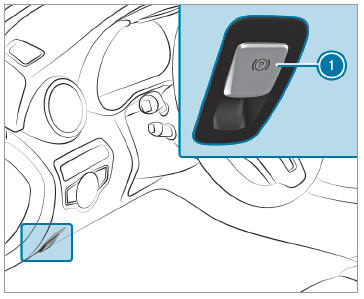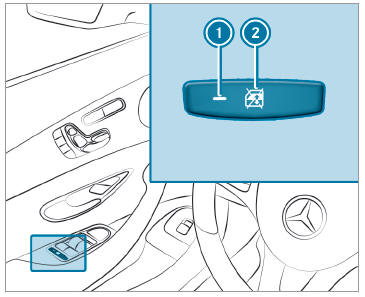Mercedes-Benz GLC : Parking / Electric parking brake
Function of the electric parking brake (applying automatically)
WARNING Risk of accident and injury due to children left unattended in the vehicle
If children are left unsupervised in the vehicle, they could, in particular:
- open doors, thereby endangering other persons or road users.
- get out and be struck by oncoming traffic.
- operate vehicle equipment and become trapped, for example.
In addition, the children could also set the vehicle in motion, for example by:
- releasing the parking brake.
- changing the transmission position.
- starting the vehicle.
 Never leave children
unattended in the
vehicle.
Never leave children
unattended in the
vehicle.
 When leaving the vehicle,
always take
the SmartKey with you and lock the
vehicle.
When leaving the vehicle,
always take
the SmartKey with you and lock the
vehicle.
 Keep the vehicle SmartKey
out of reach
of children.
Keep the vehicle SmartKey
out of reach
of children.
The electric parking brake is applied if the transmission
is in position  and one of the
following
conditions is fulfilled:
and one of the
following
conditions is fulfilled:
The engine is switched off.
The seat belt tongue is not inserted in the seat belt buckle of the driver's seat and the driver's door is opened.
To prevent application: pull the handle of the electric parking brake.
In the following situations, the electric parking brake is also applied:
- Active Distance Assist DISTRONIC is bringing the vehicle to a standstill.
- The HOLD function is keeping the vehicle stationary.
- Active Parking Assist is keeping the vehicle stationary.
This is the case if one of the following conditions is also fulfilled:
- The engine is switched off.
- The seat belt tongue is not inserted in the seat belt buckle of the driver's seat and the driver's door is opened.
- There is a system malfunction.
- The power supply is insufficient.
- The vehicle is stationary for a lengthy period.
When the electric parking brake is applied, the
red  (USA) or
(USA) or
 (Canada) indicator lamp
lights up in the instrument cluster.
(Canada) indicator lamp
lights up in the instrument cluster.
The electric parking brake is not automatically applied if the engine is switched off by the ECO start/stop function.
Electric parking brake function (releasing automatically)
The electric parking brake is released when the following conditions are fulfilled:
- The driver's door is closed.
- The engine is running.
- The transmission is in position
 or
or
 and
you depress the accelerator pedal or you
shift from transmission position
and
you depress the accelerator pedal or you
shift from transmission position
 to
to
 or
or
 when on level ground with the
driver's
door closed.
when on level ground with the
driver's
door closed. - If the transmission is in position
 , the tailgate
must be closed.
, the tailgate
must be closed. - The seat belt tongue is inserted into the seat
belt buckle of the driver's seat.
If the seat belt tongue is not inserted into the
seat belt buckle of the driver's seat, one of
the following conditions must be fulfilled:
- You shift from transmission position
 .
. - You have previously driven at speeds greater than 2 mph (3 km/h).
- You shift from transmission position
When the electric parking brake is released, the
red  (USA) or
(USA) or
 (Canada) indicator lamp
in the instrument cluster goes out.
(Canada) indicator lamp
in the instrument cluster goes out.
Applying/releasing the electric parking brake manually
Applying

 Push handle
Push handle
 .
.
The red
(USA) or
(Canada) indicator lamp lights up in the instrument cluster.
The electric parking brake is only securely applied if the indicator lamp is lit continuously.
Releasing
 Switch on the ignition.
Switch on the ignition.
 Pull handle
Pull handle
 .
.
The red  (USA) or
(USA) or
 (Canada) indicator
lamp in the instrument cluster goes out.
(Canada) indicator
lamp in the instrument cluster goes out.
Emergency braking
 Press and hold handle
Press and hold handle
 .
.
As long as the vehicle is driving, the Please Release Parking Brake message is displayed and the red
indicator lamp flashes.
When the vehicle has been braked to a standstill, the electric parking brake is applied. The red
(USA) or
(Canada) indicator lamp lights up in the instrument cluster.
 Garage door opener
Garage door opener
Programming buttons for the garage door opener
DANGER Risk of death caused by
exhaust gases
Combustion engines emit poisonous exhaust
gases such as carbon monoxide...
 Information on collision detection on a parked vehicle
Information on collision detection on a parked vehicle
If a collision is detected when the tow-away
alarm is armed on a locked vehicle, you will
receive a notification in the multimedia system
when you switch on the ignition...
Other information:
Mercedes-Benz GLC 2016-2025 Owners Manual: Overview of the symbols and functions in the media menu
..
Mercedes-Benz GLC 2016-2025 Owners Manual: Reduced restraint system protection
WARNING Risk of injury or death due to modifications to the restraint system Vehicle occupants may no longer be protected as intended if alterations are made to the restraint system. Never alter the parts of the restraint system. Never tamper with the wiring or any electronic component parts or their software...


 To activate/deactivate: press button
To activate/deactivate: press button
 . The rear side window can be opened or closed in the following cases:
. The rear side window can be opened or closed in the following cases: is lit: via the switch on the driver's door
Indicator lamp
is lit: via the switch on the driver's door
Indicator lamp  is off: via the switch on the corresponding rear door or driver's door
is off: via the switch on the corresponding rear door or driver's door